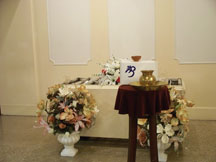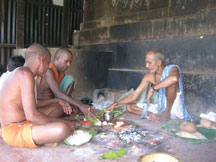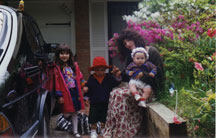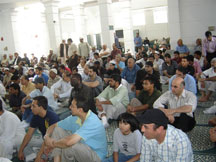Life
Life And Death In America

When Yama Comes Calling
|
You can change your name, your address. Change continents, change your face, your identity. But there’s no fooling Yamaraj, the Lord of Death. Unerringly and with a practiced eye he finds you when it’s your turn. Growing up in India, death was something you brushed against in the bazaar – the chanting of a passing funeral procession, the rituals of a distant relative’s death. Sometimes it was more traumatic – the death of a beloved parent – and you were fraught with a sense of utter loss, which hit you like a physical blow as you saw with unseeing eyes the surreal sight of hundreds of shoes and chappals lined up outside your home as mourners sat bare-foot on the ground. Death ceremonies were an inevitable part of living. As immigrants uproot themselves and start new lives, death is always an unseen presence and materializes when you least expect it. It’s that late night phone call with the earth shattering news. It’s that farewell which never gets said, as oceans and continents separate grown children and the parent who is lost forever. Vikas Kamat of Birmingham, Ala., knows the trauma all too well. He came to the United States from Bangalore for graduate studies and stayed on to found his own IT consultancy company, Cyber Crow. News of his father’s death came suddenly, as such news always seems to. “That happens to a lot of people of my generation. You know your parents are getting old, but it still comes as a shock when it happens,” he says. “When it actually happens, you are really not prepared for it. We Indians, we all want to die in India, we want to die at home and when we die, we want our children to be near us. “So there is an expectation with these parents that their children who are living out of country to be there for the support and the last rites. It’s not easy to find an air ticket, but you are expected to be there no matter what the cost.” Ten years ago, when there were few flights to India and certainly no direct flight to Bangalore, Kamat remembers the heartache of that return journey. “The journey itself is very difficult. You’re all by yourself, you’re anxious, and you can’t bear to eat anything, because you’re grief struck,” he says. “Yet it’s worth all the difficulties. I encourage anyone who is in my position to go. In India it’s a duty and responsibility that you have to fulfill.”
For immigrants there are the added complications of status: those with temporary visas could forfeit their ability to return; for students their studies could be compromised. Kamat says, “So there are a lot of conflicted decisions. People have to make these decisions in India too, but here, because of immigration issues you may not be able to come back to a house or a job if you go.” Kamat, who is a Saraswat or Konkoni Brahmin, says, “My father was a very rational man and I also don’t believe in rituals, yet I ended up doing the rituals I condemned all my life, because in some ways I understood that rituals have a meaning, they have a purpose and are part of the healing process.” If going to India for the death rituals of a loved one is hard, trying to conduct them in America can sometimes be even harder. A year ago, a visiting father of Kamat’s friend died suddenly in Birmingham, Alabama. It turned out there were no cremation facilities in Alabama for humans, although there was one for animals. He recalls, “He actually had to put the body of his dead father in the car and drive about five hours to another state where there were such facilities.” As the Indian population has grown and as many mainstream Americans also turn to cremation, these services are now available nationwide. For many immigrants who came here in the 1960’s and even the 1970’s, death is becoming something upfront and personal. Age is catching up. It is calling on friends or people they know well. Death is no longer something distant, something you read about. Its feel, its touch is experienced at close quarters. Increasingly, it is as much a part of living as birth and celebrations. And with this has come the sad, but necessary, task of death rituals, consoling the bereaved and dealing with unfinished business. In India, for Hindus, funeral rituals spread over 12 days of mourning, of family gatherings to send their loved one into the next world, with bhajans, prayers, meals for the Brahmins and alms for the poor. How does one do all that in this frenetic world of work, few support systems and a new culture? Madhulika Khandelwal, director of the Asian Center at Queens College, has observed the changes. She recalls the death of an uncle in New York when she first came to the United States 20 years ago: “They were the only people we knew here. His wife and children were in shock. So my husband stepped in. But we were also young and new. We had no idea what to do. It was one of the most baffling things for me in the US and also a huge culture shock.” She recalls their puzzlement when a chaplain came to deliver the news in the waiting room of the hospital. They were told the body had been sent to a morgue and would be released only to the funeral home, which is standard procedure here. Dealing with funeral homes and hospitals was a new and traumatic learning experience. She says, “Eventually my husband and the family members flew with the body to India so all the rites could be done there. It seemed the best way to handle the situation, because we didn’t know what to do and there was no one here for the family. That’s when you feel suddenly so lonely.” She adds: “Now so many incidents have happened that the community has created a learning, a knowledge base, an experience base and knows how to respond to these situations. There are so many organizations now that can address these issues. When the community starts pitching in, then there’s community knowledge and not the struggle of one person.” Unlike India, where death rites are performed in the home, in the United States the funeral home takes center stage. “So the setting becomes different, that of a funeral home. You realize how new you are, you realize how different you are and that this is not your culture,” Khandelwal says. “There’s a distinct American influence and it’s hard to recreate the Indian conditions here where you can get the whole community involved. People have basically accepted the fact that they are relying on local professionals and services.” In India, the oldest son sets the flame to the funeral pyre as part of a time-honored ritual, but here it’s as prosaic as pressing the button for the cremation. “If you think of that in terms of the image, for me this is the difference. You could call it American or adjusting to the customs here. It is adjusting to what is practical and what is doable here. Ideally many would prefer to go to India and get all the ceremonies done, but it’s not feasible,” she says. One man who saw the need in the community and has long offered assistance to bereaved families is Nanik Massand, a successful entrepreneur in New York. Assisted by Ram Sakhrani, also of New York, the two volunteers help grieving families find an appropriate funeral home that fits their budget and location, and most importantly has a crematory attached to it. They help arrange pandits and granthis for the markha ceremonies and the reading of the Guru Granth Sahib. Massand has helped some of them arrange for the ashes to be sent by flight to India to be immersed in the Ganges at the holy Har ki Pauri. Memorial services for parents who have passed away in India are routinely held in Indian temples and gurudwaras by NRI sons and daughters, where friends turn up in force to share their grief. While most airlines have arrangements to fly bodies to India, Air India also has a special service to return ashes to India, into the custody of relatives who will do the final immersion. The Indian Consulate handles the documentation when bodies have to be flown back home, which can happen when Indian nationals who are working or studying here pass away suddenly and have to be returned to their families. According to Sasi Kumar, Consul for Passports and Visas at the Indian Consulate in New York, for Indians seeking to send bodies back home, the consulate requires the deceased’s Indian passport, a death certificate and an embalmment certificate, which are all secured from the funeral home. The consulate authenticates the documents and issues an authorization. A cremation certificate from the funeral home is needed to send the ashes back to India. “There are many people who send the bodies to India, especially the Hindus,” says Kumar, adding that 20 such transfers occurred last year. “I have also seen that among the Christians too. The family members there want that. Even Indian-Americans often do the last rites in India.” All across the U.S., especially in cities with large Indian populations, temples offer ritual services by priests for the bereaved. Many communities have their own special rituals, be they Bengali or Tamil. “First regions come in, then culture,” says Khandelwal. “It all depends on what kinds of resources and what kinds of networks the community has created over the years. If you’re in a small town, then Bengali and Gujaratis will find commonalities. If 10 people from a community die in a year then people from that subgroup begin to respond to it and are better prepared the next time.” Not coincidentally, some of the most coordinated death services are available in temples and gurudwaras, many of which are founded by Gujaratis, Sikhs and Punjabis. All three have a very long diasporic history and are often more organized than other communities, especially in the development of religious centers. Jogeshwar Preet Singh, who came to California in 1965 and helped found The Sikh Center of the San Francisco Bay area, remembers some of the tragedies. When a man, who was terminally ill with cancer, expressed a desire to live in the gurudwara so he could be constantly surrounded by kirtan and paths, he was allowed to do so until his death. More recently, when a cab driver was stabbed and killed, days before he was to leave for India to get married, the community chipped in to ship his body home to his grieving family. But most immigrants have to cope with death in America and that has meant having to modify time-honored death rituals. In India, bodies are never held and usually cremated by sundown. But in America, hrefrigeration facilities allow bodies to be until family members arrive from far-flung parts of the world to participate in the rituals.
The funeral parlors, with their very Christian ambience, are places where people grieve and perform rituals, sitting on chairs in a very westernized room. When grieving at home, mourners typically sit on the floor. Whereas in India everyone strictly wears white for the funeral, here mourners sometimes turn out in black or light colors besides the traditional white. Some families bring images of their Gods as well Hindu priests for the ceremonies in funeral homes. Funeral homes often accommodated the rituals; in many cases they remove the chairs so mourners can sit on the floor for the mourning rituals. The ceremonies are often truncated or conducted by family members. At one recent memorial service in New Jersey, the priest conducted ceremonies in Sanskrit but with English explanations, so that children, non-Indian relatives and friends could understand the rituals. “The viewing traditions have become very Americanized. So they start from the back of the hall and come to view the body,” says Singh. Eulogizing, which is a very western custom, is now common at Indian funerals. At one recent memorial, three sons-in-law spoke tenderly of the man who had just passed away. This is not something one would find in India, but the warmth and emotion somehow made perfect sense. The little grandchildren were dressed in white, and the littlest ones even shouted out “We love you, nana!” A message that surely brought a cheer to their grandfather. In India, mourners rarely look up and unadulterated grief consumes the event. “Eulogizing is done lots more now and was not a tradition in India. The immediate family speaks in the funeral home, which is very different from the way it’s done in India,” says Singh. The rush of life in America allows little opportunity for protracted mourning. The workplace can’t be ignored nor the needs of housework, as there is little help or extended family for support. Widows often revert to wearing colored clothes, return to work and try to move on with life. Other ritualistic changes are occurring. One emerging trend is female priests who conduct the death ceremonies, and sometimes female relatives also push the button at the crematorium, a task traditionally reserved for males.
Neelima Shukla-Bhatt, professor of South Asian Studies at Wellesley College, finds that women in India are now being trained as priests and this trend is slowly finding its way in America, as Indian women see these ritual services as part of community service and a way of keeping the culture alive. Says Bhatt: “Becoming a woman priest in itself is a departure from what has been the custom for many centuries and so women are more open to doing things differently.” Pandita Indrani Rampersad Rampersad, who works as a school teacher, is qualified in all 16 Sanskaras and performs them both in New York and Trinidad. She says, “A lot of this is educational. When I perform rituals I use a lot more of the time for educating; the ritual for me is the center around which I can educate. For a lot of the male priests the ritual is the center and that’s it.” These part-time women pujaris often conduct the services in English to reach out to the younger generation. Many gurudwaras offer services to bereaved families and granthis in their homes. In California, a Sikh chaplains attends to people who die in accidents or in hospitals. Like Hindus, it is important for Sikhs to take the ashes back to the homeland and immerse them in holy water. “Most of the ashes go back to Kiratpur Sahib, close to Anandpur Sahib in Punjab. It’s the final resting place for the ashes of all the Sikhs.” says Singh. “These are immersed in the Sutlej River. I would say the majority of the Sikhs keep the ashes in the urn in the funeral home, and when the family is ready to go to India they take the urn with the ashes to Kiratpur Sahib. At the same time, there are Sikh families from Patiala and their sacred places are in Haridwar so they still take the ashes to the Ganges for immersion.” But it is not uncommon for Sikh families in San Francisco to immerse the ashes in the Bay. Mainstream funeral homes are becoming savvy about the needs of the community and adapting to the changing demographics of the country. JP Di Troia, president of Fresh Pond Crematory and Columbarium, founded in 1884, one of the oldest in the U.S., says: “We are serving and embracing the customs of many cultures, including the Indian community by providing services at our chapel specialized and customized to their rituals.” He works closely with pundits and the Indian community and has actually created a special crematorium room to service Hindus. While Hindus generally consign the ashes into the Ganges, some are now adapting to the American tradition of housing the ashes in a columbarium. Di Troia relates the story of the Hemchand family, which came from India to visit the columbarium where the mother’s cremated remains have rested since 1945. It was a touching moment as the great grandchildren, ages 8 and 10, paid tribute, pulling out their spending money to make a donation in their great grandmother’s memory. “The son said that his father wanted to make sure that his wife would be remembered always and that is why he broke from tradition and placed her ashes in the Columbarium Niche, where they have been cared for the last 62 years,” says Di Troia. “Many customs in the Indian community are changing gradually and of course this break from tradition for this family truly had a special meaning for the generations to come. By memorializing the cremated remains in the niche, the heirs will always have a place to go to remember and pay respects to those who have moved on.”
For most Hindus, though, the immersion of the ashes in the holy Ganges remains sacrosanct. Many families take the ashes back to India to perform this final goodbye while others who cannot make the journey immerse them in a river nearby. But now an American company has a solution for those who desire to take the ashes to Ganges, but lack the time, or the finances. Allan Pirie is co-founder of Sacred Rites of the Ganges (SRG), a company based in Sarasota, Fl., with offices in Varanasi. He has partnered with Kameshwar Singh, who supervises the procedure of returning the remains to the Ganges in Varanasi. “The company is dedicated to helping Hindu families celebrate the life of their loved ones, making it possible to complete the traditional Asthi Visarjan ceremony and return their ashes to the holy waters of the Ganges,” says Pirie. The company has 11 employees, nine in Varanasi, including Hindu priests who conduct the immersion ceremonies. Started in 2006, SRG has hi-tech equipment to bring age-old traditions into the modern age through computers and digital cameras, recording the ceremony for U.S.-based family members.
Pirie says the family is instructed to send a special family photograph or icon particular to the family. When the family receives a DVD of the ceremony, they see the image with the ashes being immersed into the Ganges, celebrating the final journey of their loved one. The company’s services, which include the collection of the ashes from the family, flying them to India, immersing them in the Ganges, and recording the process on DVD, cost $1,200. Pirie says, “What we find is that family members are touched that there is a way they can accomplish this ceremony without actually having to go there.” But for some a remote ritual doesn’t quite resonate. Says Vikas Kamat, who had returned home to conduct his father’s last rites, “I personally would like to die in India.” He says he would like at least the ashes to be sent back. He has friends who have actually sent the bodies of their relatives home. It’s expensive, but the body can be chemically treated and sent by most airlines. He feels it’s like a final resting place, the sense that you have finally gone home. “Hindus don’t have the concept of a memorial, which, I think, is not so good. With Christians you can go where the body is buried, offer flowers and remember, but Hindus don’t do that. We believe in disintegrating completely, so there’s the concept of scattering the ashes on mountains and rivers, be it in the Ganges, Yamuna or Kaveri.” Once the soul has flown, according to Hindu philosophy, the body is to be discarded, like a worn-out robe. So the concept of a memorial site is really more for the survivors, the people left behind. In Hindu dharma, there is the concept of Samadhi. But there’s a larger all-embracing factor connected with the immersion of the ashes, says Kamat: “That whole river becomes a memorial. You can go to any part of the Ganges and say, the ashes of my ancestor were scattered here, so their spirit is there.”
|










You must be logged in to post a comment Login